0025 Is Genesis 1 a sign of the evolutionary record?
If it is, then it is a sign composed of signs.
In other words, the answer is not straightforward.
0026 Charles Peirce (1839-1914 AD), the founder of postmodern semiotics, defined a sign as a triadic relation. A sign-relation consists of a sign-vehicle, a sign-object and a sign-interpretant.
Here is a picture of the sign-relation.
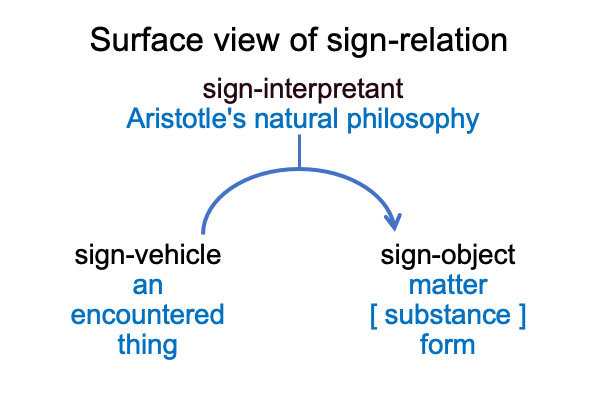
An encountered thing (sign-vehicle) stands for the hylomorphe, matter [substantiates] form (sign-object) in regards to Aristotle’s natural philosophy (sign-interpretant).
On the surface, the sign-vehicle associates to Peirce’s category of firstness, which contains only one element (however complex that element may be). For example, an image or a person belongs to the category of firstness (there is only one of them) and may serve as a sign-vehicle. Firstness is the realm of possibility.
On the surface, the sign-object associates to Peirce’s category of secondness, which contains two contiguous real elements. Perhaps the most famous example is Aristotle’s hylomorphe. Matter and form are two real contiguous elements. According to my nomenclature, the contiguity is placed in brackets. In the previous figure, I use the term, “substance”, to label the contiguity between matter and form. Secondness is the realm of actuality.
On the surface, the sign-interpretant associates to Peirce’s category of thirdness, which contains three elements, one belonging to each category. Thirdness brings secondness into relation with firstness. Thirdness is the realm of signs, normal contexts, mediations, judgments and so on.
0027 So, why the qualifier, “on the surface”?
Take a look at the sign-vehicle. Obviously, the sign-vehicle should belong to firstness, because it makes the sign-relation possible. At the same time, the sign-vehicle is an encountered thing. So, it must belong to the realm of actuality. The sign-vehicle must be so actual as to trigger the operation of a sign-interpretant. For example, a silver coin (sign-vehicle) stands for the metal silver [substantiating] a round imprinted form (sign-object) in regards to an Aristotelian view of money (sign-interpretant). Come to think of it, the sign object also belongs to the realm of actuality.
0028 Why is the triadic structure of the sign-relation important?
Both Genesis One and the evolutionary record are actual. Yet, on the surface, the Creation Story associates to firstness and the scientific evolutionary record associates to secondness. So, the former should be taken as a sign-vehicle and the latter should be regarded as a sign-object.
What do these associations imply?
Genesis One is a sign of the evolutionary record.
So, in a day-age association, the day corresponds to a passage in the Genesis text and the age corresponds to a period in the evolutionary record. The day is the sign-vehicle and the age is the sign-object. The sign-interpretant will rely on a sign-typology based on natural signs.
0028 To start, here are the day-age associations for days one through three.
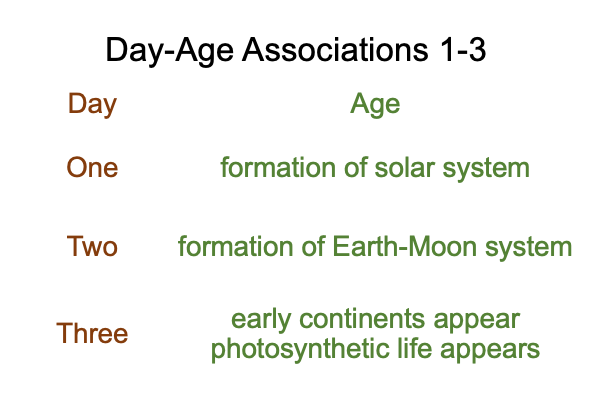
0029 Here are the day-age associations for days four through six.
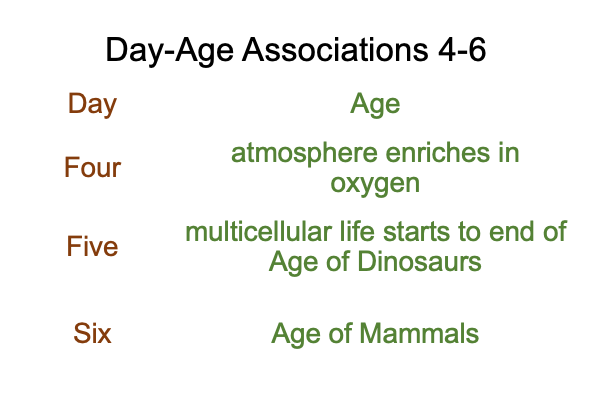
0030 Here are the verse-age associations for the creation of humans in the image of God.
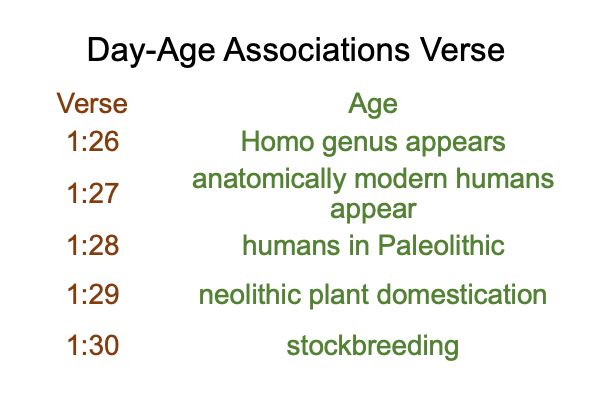
0031 The first chapter of Genesis concludes with a sign of the Developed Neolithic, setting the stage for a second creation of humans, starting with Genesis 2.4.
0032 The Genesis day is the sign-vehicle. The corresponding scientific epoch is the sign-object.
What about the sign-interpretant?
Peirce identifies three types of natural sign, based on the categorical qualities of the sign-object.
For an icon, the sign-object carries the categorical qualities of firstness. So, I read a Genesis verse as a picture of the corresponding epoch.
For an index, the sign-object carries the categorical qualities of secondness. So, I read a Genesis verse as something that points to a characteristic of the corresponding epoch, especially in regards to what the visionary must be wondering about the ongoing revelation. An index points to the location of the witness. The Genesis statements about morning and evening are indexes.
For a symbol, the sign-object carries the categorical qualities of thirdness. So, I read a Genesis verse in terms of convention. The declaration at the end of most days, where God declares the day, “good”, associates with symbols.
0033 Here is a list of the three types of natural sign.
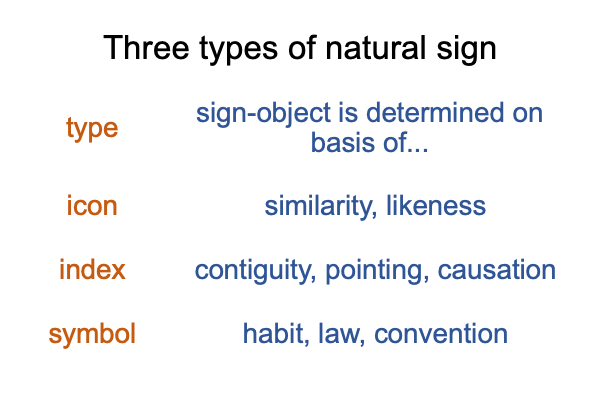
0034 For example, in day four, the text points to a visionary, located on the surface of the Earth, looking up, and witnessing the haze of the atmosphere of the early Earth clear away as the atmosphere increases in oxygen content.
Here is a picture of the associations, based on sign-typology as the sign-interpretant.
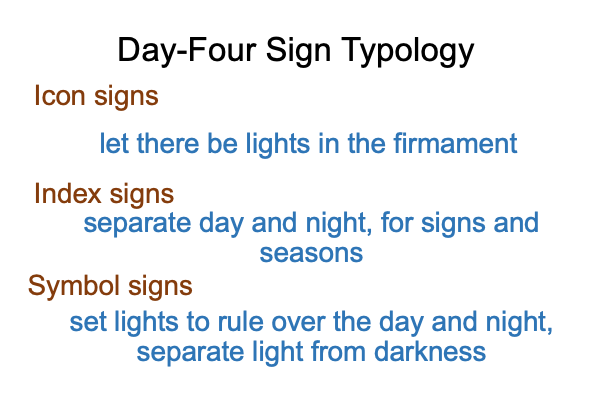
0035 In sum, in day four, the stars, planets, moon and sun become visible.
